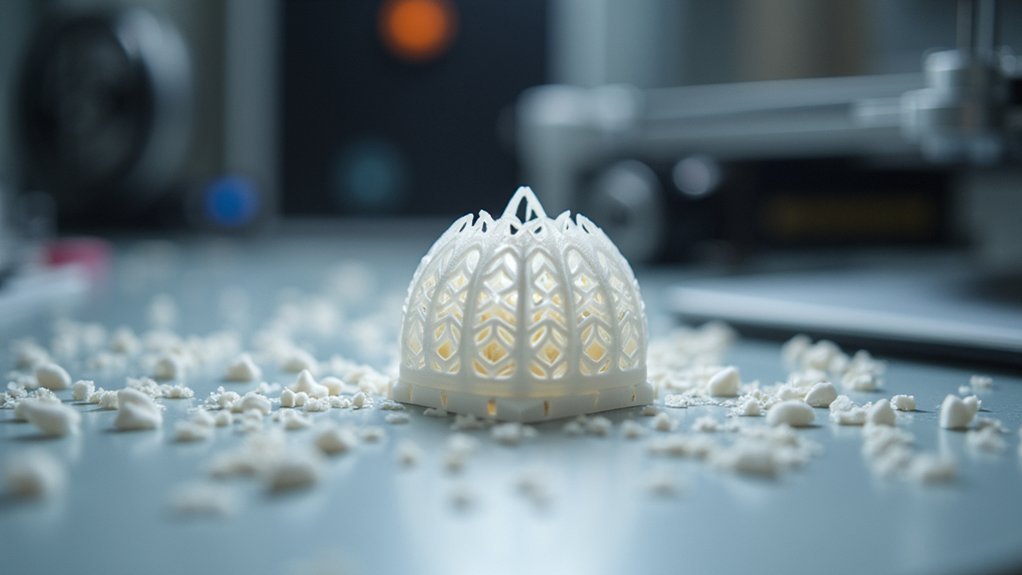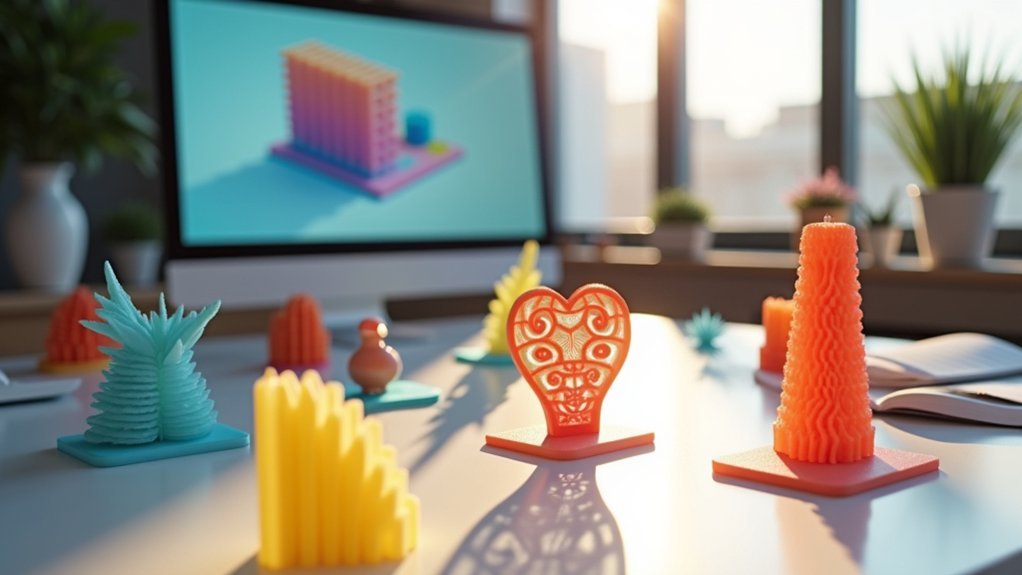You can cut support material waste by up to 50% through strategic optimization techniques. Start by adjusting print orientation to minimize overhangs and implementing variable density supports that use 30% less material than uniform alternatives. Switch to sparse patterns like “lines” or “grid” in your slicer settings, and consider soluble supports like PVA that dissolve completely in water. Choose lightweight, biodegradable materials and establish recycling programs for failed prints to maximize sustainability and discover advanced methods that’ll transform your printing efficiency.
Optimizing Support Structure Design Parameters

When you’re designing supports for additive manufacturing, optimizing the structural parameters can slash material waste by up to 60% while maintaining the integrity your parts need.
You’ll achieve significant waste reduction by implementing variable density supports, which reduce material consumption by 30% compared to uniform alternatives. These intelligent supports provide adequate strength in critical areas while using less support material elsewhere.
Lattice structures offer another powerful approach, creating supports that’re 50% lighter while preserving structural integrity.
You can leverage simulation tools during design to predict and eliminate unnecessary supports, boosting manufacturing efficiency.
Don’t overlook the impact of part orientation—when you optimize orientation to minimize overhangs, you’ll dramatically reduce support requirements.
Smart design parameters transform waste reduction from afterthought to competitive advantage.
Selecting Appropriate Support Material Types
When you’re selecting support materials, you’ll need to analyze their composition to understand their environmental impact and disposal requirements.
You must evaluate durability criteria to guarantee the materials can withstand your intended use while maintaining their structural integrity.
This assessment helps you balance performance needs with waste reduction goals, making sure you don’t sacrifice functionality for sustainability.
Material Composition Analysis
Three critical factors shape effective material composition analysis: environmental impact assessment, lifecycle evaluation, and performance requirements.
You’ll need to examine how different support structures affect waste generation throughout production and disposal phases. When conducting material composition analysis, you’re identifying sustainable options that minimize waste while maintaining structural integrity.
Choose biodegradable materials or options that support recycling programs to reduce landfill contributions by up to 30%. Implementing eco-friendly materials like recycled paper or plant-based plastics meets consumer demand while conserving resources.
Lightweight alternatives decrease material usage by 20-40%, improving transportation efficiency.
Comprehensive lifecycle analysis enables informed decisions from production to disposal. You’ll optimize both environmental performance and operational costs by selecting appropriate materials that enhance sustainability throughout your product’s lifecycle.
Durability Assessment Criteria
Proper durability assessment criteria form the foundation for selecting support materials that minimize long-term waste generation.
You’ll need to evaluate tensile strength, impact resistance, and environmental resilience to guarantee material performance meets your project requirements. Conducting life cycle analysis helps you understand the environmental impact from production through disposal, enabling informed decisions about sustainability.
Use ASTM testing protocols to gather reliable data on how materials perform under various conditions.
Focus on materials with high durability ratings that exhibit minimal wear and tear, as they’ll reduce overall waste by decreasing replacement frequency. Incorporate supplier certifications and eco-labels into your selection process to guarantee responsible sourcing practices.
This extensive approach helps you reduce waste while maintaining quality standards throughout manufacturing processes.
Implementing Smart Support Placement Strategies

Although traditional support placement often relies on automated software defaults, you can dramatically reduce material waste by strategically positioning supports only where they’re structurally essential.
Smart support placement strategies help you optimize location decisions through simulation software that analyzes structural requirements, potentially decreasing material usage by 30%. This approach doesn’t just minimize material usage in additive manufacturing—it’ll enhance print speed and reduce post-processing time.
You’ll achieve better material efficiency by designing supports that dissolve easily or remove cleanly.
Implementing continuous monitoring and data analysis of your support patterns creates valuable insights for future iterations. These waste reduction strategies transform your production cycle, making each print more sustainable while maintaining structural integrity and reducing finishing waste.
Utilizing Soluble and Breakaway Support Technologies
You can dramatically reduce 3D printing waste by switching to soluble and breakaway support technologies that eliminate the material losses associated with traditional support removal.
Soluble supports like PVA dissolve completely in water, while breakaway supports detach cleanly without damaging your printed parts.
These advanced support methods not only cut down on wasted material but also improve your print quality and reduce the time you’ll spend on post-processing tasks.
Soluble Support Benefits
When traditional support structures create unnecessary waste in your 3D printing projects, soluble support materials like PVA (polyvinyl alcohol) offer a game-changing solution that dissolves completely in water.
These soluble supports represent one of the most effective strategies for waste reduction, requiring minimal material that’s entirely removed post-printing. You’ll minimize waste considerably compared to conventional methods that often leave unusable remnants.
Soluble supports streamline production workflows by eliminating manual removal processes, reducing material waste while improving print quality. You won’t need additional tools or extensive post-processing labor.
This approach supports sustainable practices by decreasing failed prints and reducing overall material consumption. The cleaner results mean fewer defects and reprints, helping you reduce costs associated with waste management.
You’re investing in efficient, environmentally conscious manufacturing that maximizes resource utilization.
Breakaway Material Efficiency
Breakaway support materials take material efficiency beyond water-soluble options by offering mechanical removal systems that snap away cleanly without tools or excessive force.
You’ll find these materials greatly reduce waste during post-processing by eliminating the cutting and sanding typically required with traditional supports. This enhanced material efficiency makes breakaway materials ideal for sustainable practices in precision manufacturing.
When you combine breakaway materials with soluble support technologies, you’ll achieve peak waste reduction across different part geometries:
- Clean separation points that minimize waste generation
- Reduced labor time during post-processing operations
- Compatible with complex geometries requiring multiple support types
- Enhanced surface finish quality requiring less secondary processing
- Lower overall material consumption compared to traditional manufacturing practices
These innovations help you minimize waste while maintaining the precision demanded in aerospace and medical device applications.
Adjusting Print Orientation for Minimal Support Requirements

Since overhangs create the primary need for support structures, strategically adjusting print orientation can dramatically cut support material requirements by up to 50%.
By aligning your model with the printer’s natural layering direction, you’ll reduce waste and achieve significant cost savings while minimizing environmental impact.
Use simulation software to identify the best angle for printing, which helps minimize overhangs before you start.
This approach guarantees efficient use of material and eliminates excess support waste that would otherwise end up in landfills.
Smart orientation choices also boost printing speed since less support material means faster post-processing and fewer surface imperfections.
Consider modifying design elements like flattening problematic overhangs to further enhance your prints and maximize material efficiency.
Employing Advanced Slicer Settings for Efficient Support Generation
While proper orientation reduces support needs, advanced slicer settings let you fine-tune the support structures you do need, cutting material waste by another 50% through strategic parameter adjustments.
These advanced technologies provide thorough management solutions that minimize waste and maximize printing efficiency while ensuring proper disposal of excess material through automated sorting of support parameters.
Advanced slicer technologies deliver comprehensive waste reduction through intelligent support parameter automation and strategic material conservation protocols.
- Switch to sparse patterns like “lines” or “grid” to reduce the volume of waste by half while maintaining structural integrity
- Lower support interface layer thickness to reduce environmental impact and simplify removal processes
- Adjust Z-distance settings for better part-support separation and material conservation
- Implement custom support placement to reduce waste through selective positioning
- Establish recycling programs for failed prints and collective action toward sustainable printing practices
Frequently Asked Questions
What Are Some Effective Ways to Reduce Material Consumption?
You’ll reduce material consumption by implementing lean manufacturing principles, adopting Just-In-Time production, utilizing advanced technologies like IoT sensors, conducting regular inventory audits, and choosing suppliers who prioritize recyclable materials.
What Is the Most Effective Way to Reduce Waste?
You’ll achieve maximum waste reduction by implementing source reduction strategies first, then conducting waste audits to identify problem areas, and finally adopting lean manufacturing principles to eliminate inefficiencies.
Which Is the Most Effective Approach to Reducing Waste?
You’ll find lean manufacturing principles most effective for reducing waste, as they can cut waste by 30% through eliminating non-value-added activities and streamlining your processes systematically.
What Are the 4 R Methods for Waste Reduction?
You’ll apply the 4 R methods: Reduce consumption to minimize waste generation, Reuse items to extend their lifecycles, Recycle materials into new products, and Recover energy or materials from waste streams.





Leave a Reply